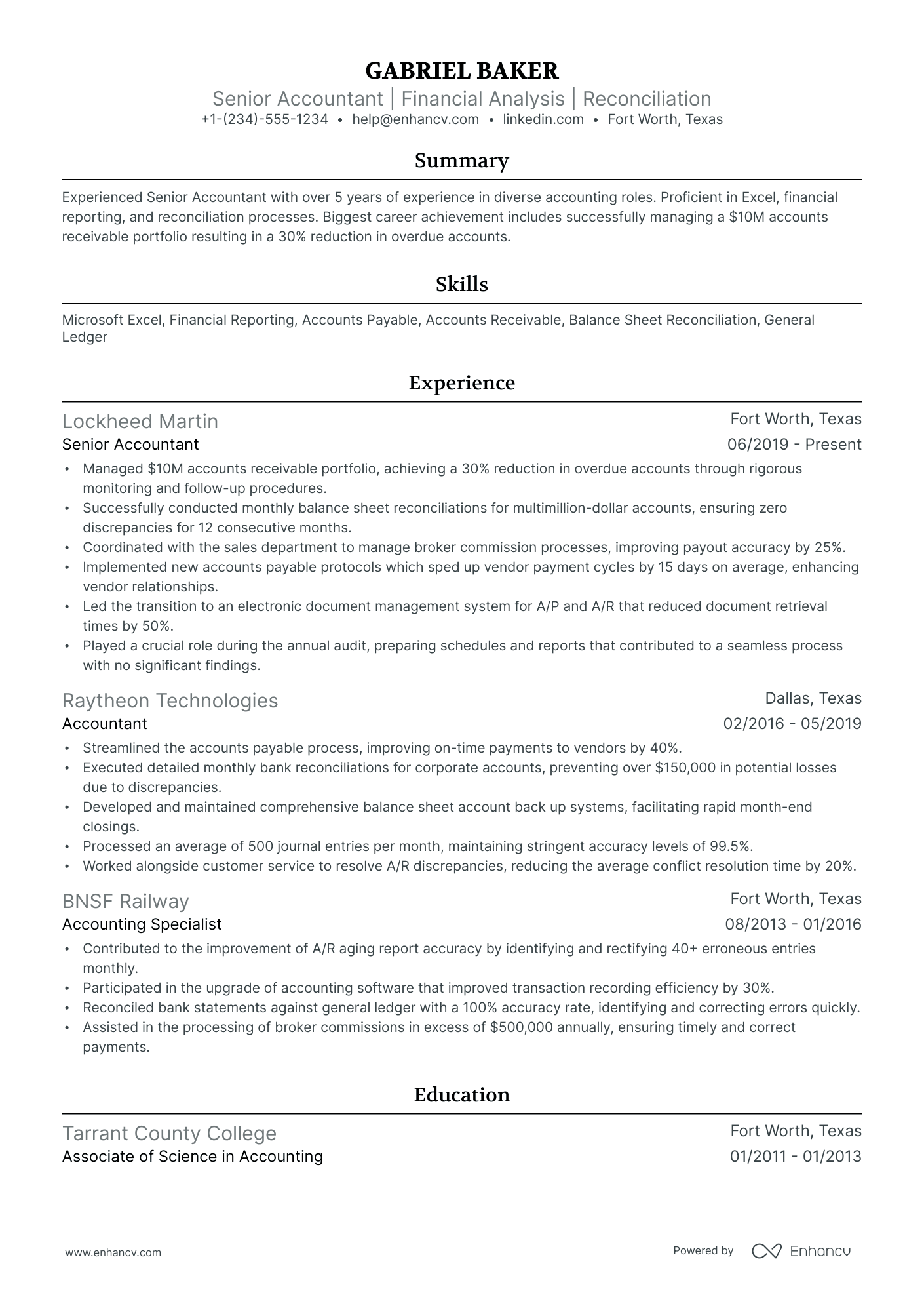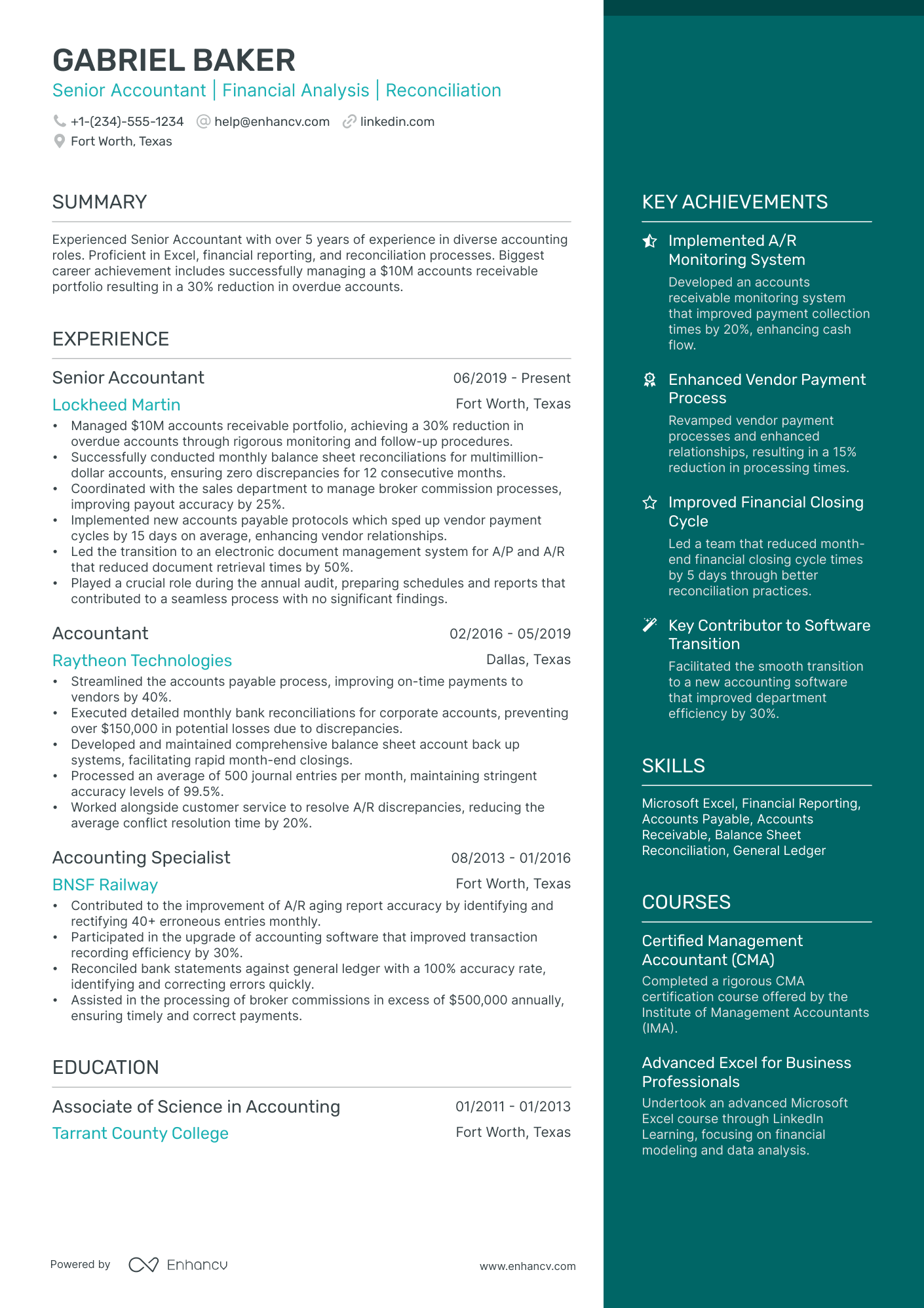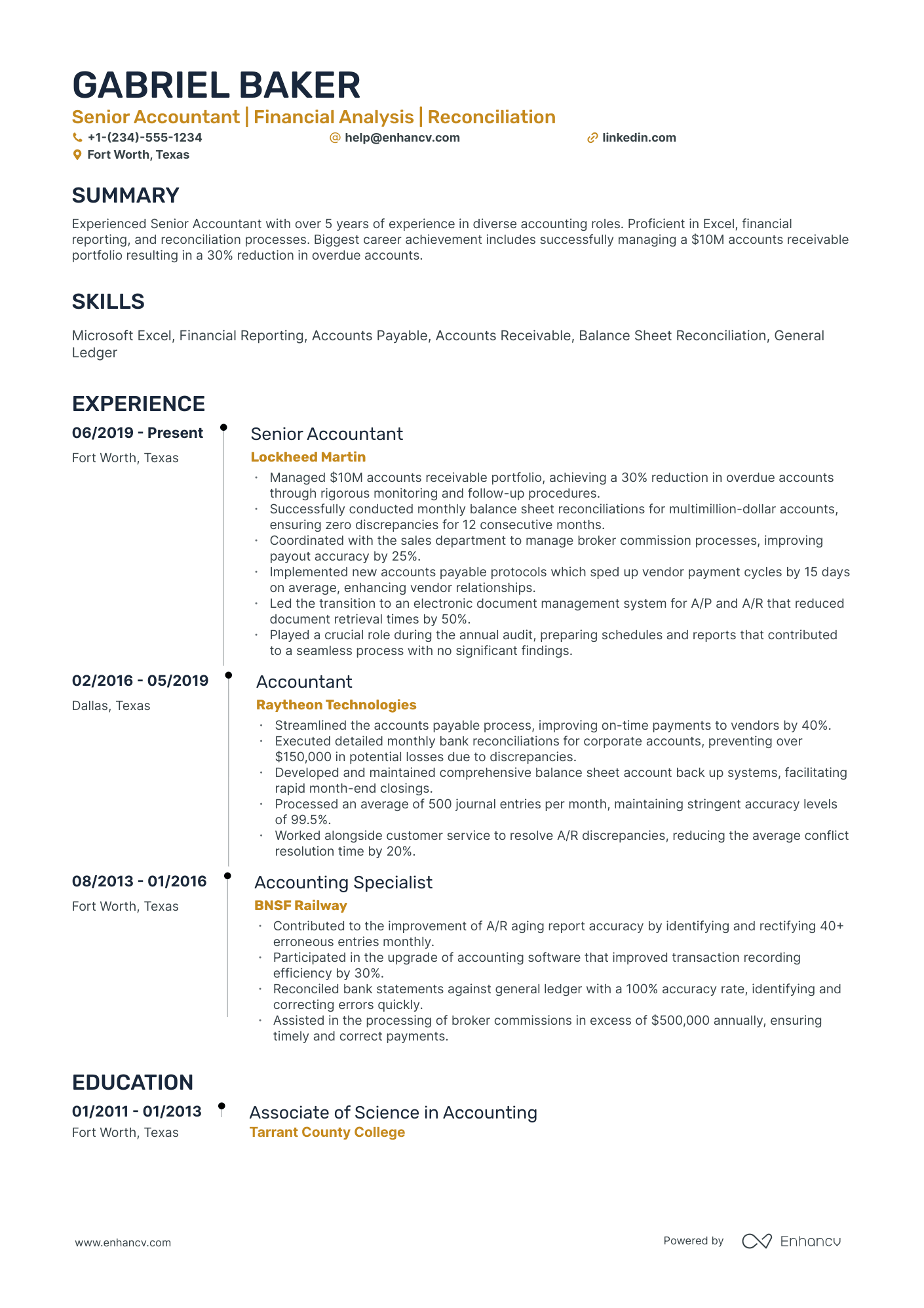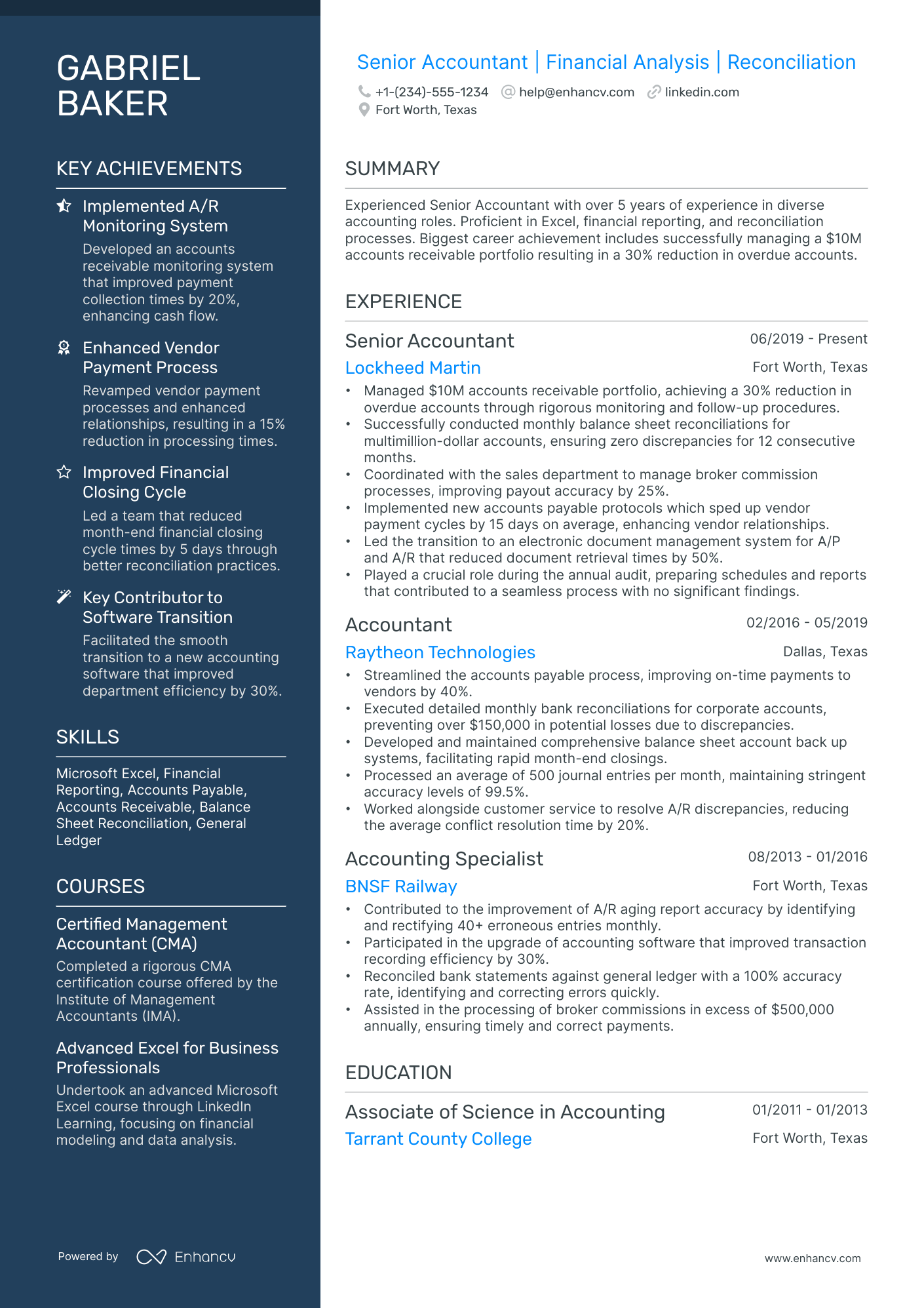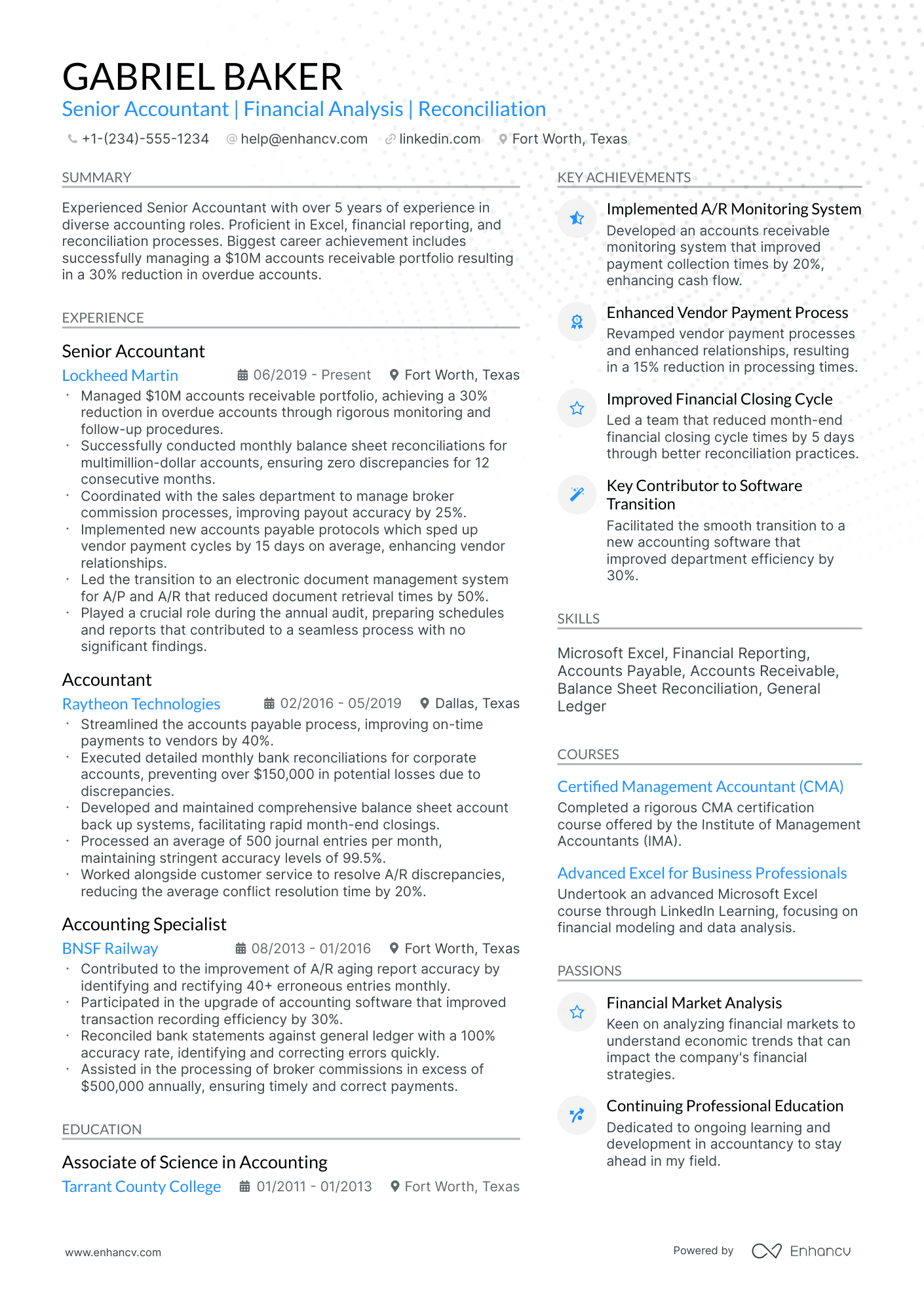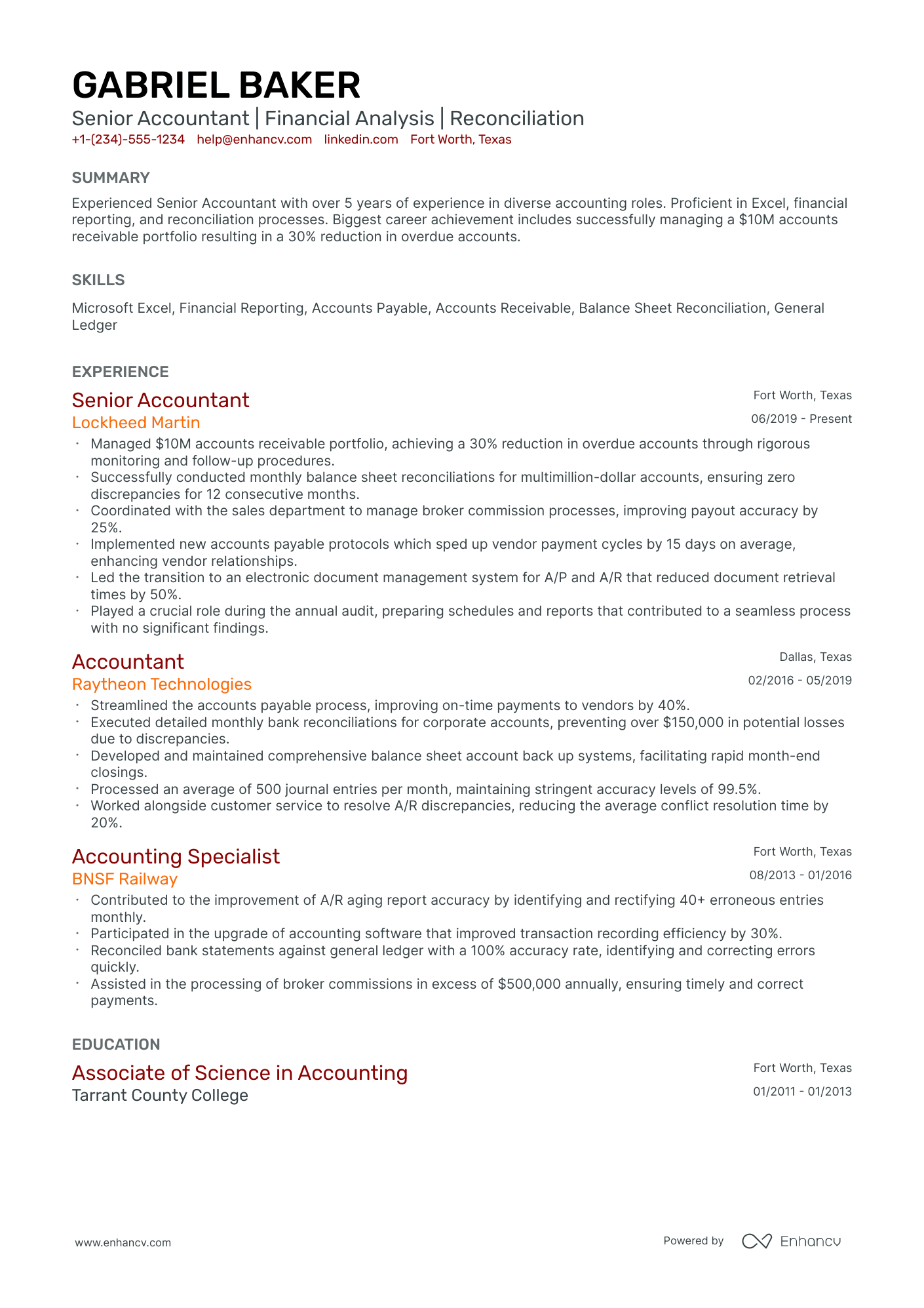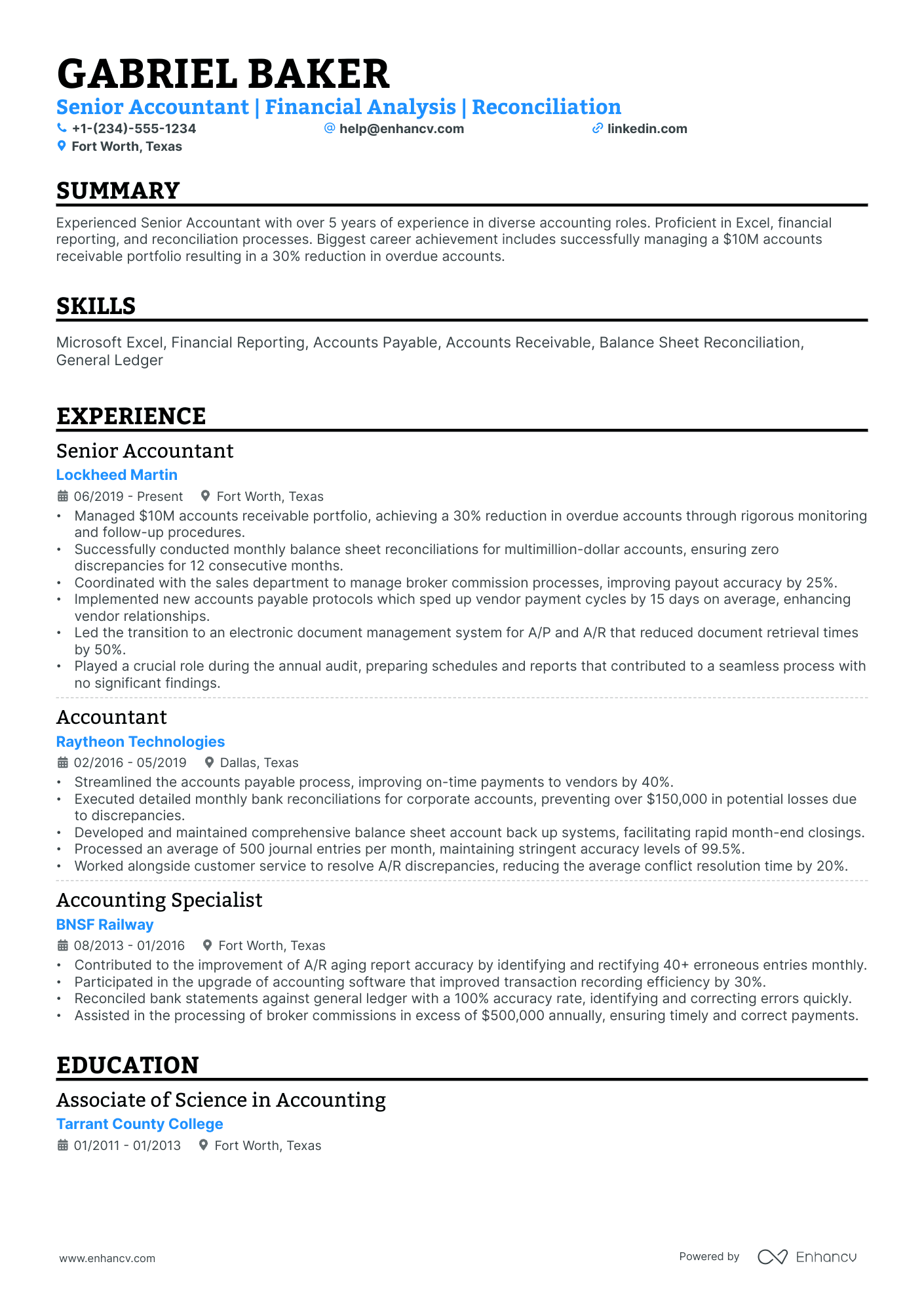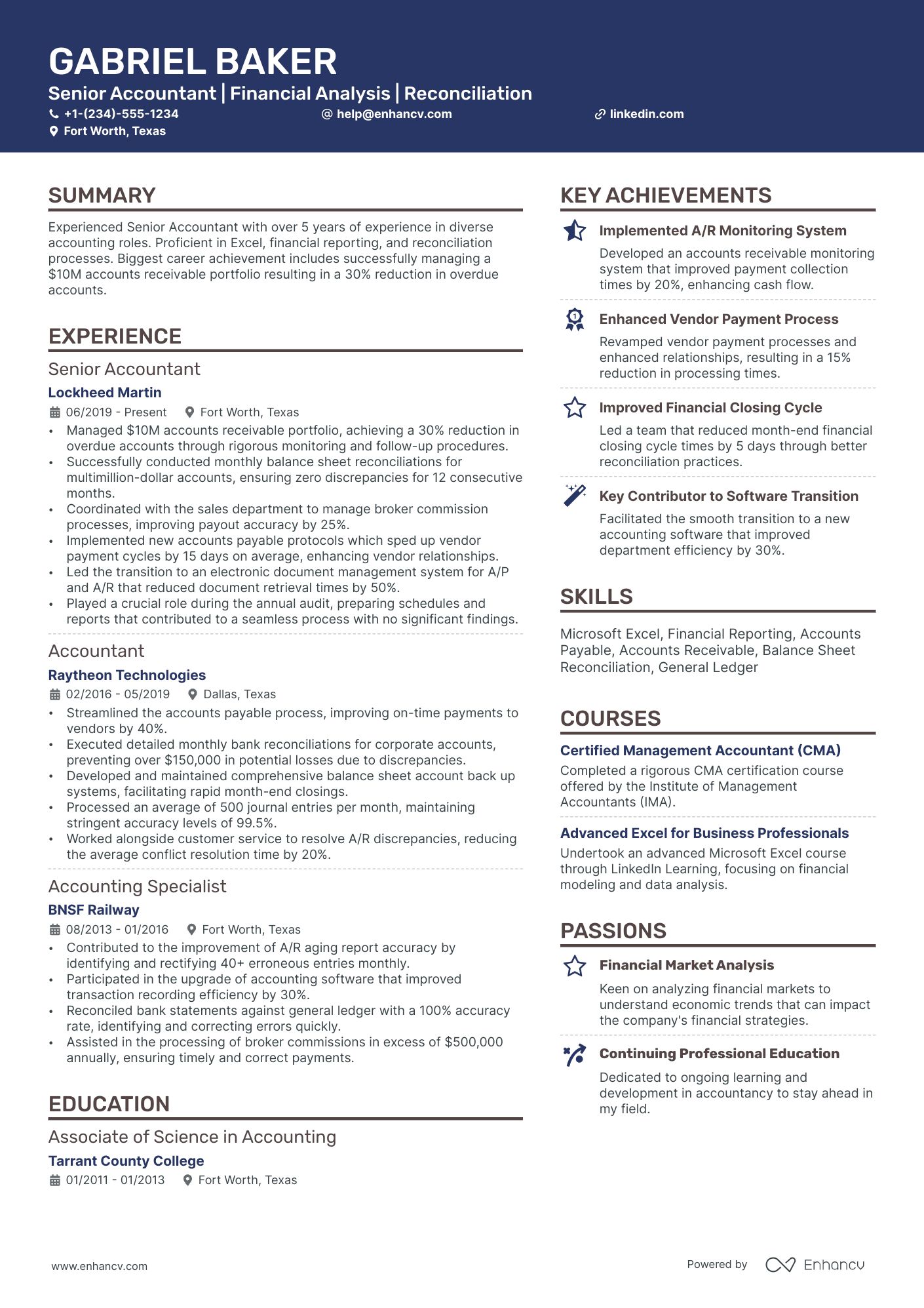One resume challenge you may face as a financial assistant is effectively showcasing your attention to detail and quantitative skills amongst a pool of candidates with similar backgrounds. Our guide provides tailored strategies to help you craft a resume that emphasizes your unique achievements and expertise, ensuring you stand out to potential employers.
- Sample industry-leading examples to learn how to write your best resume yet.
- Improve the experience, education, and achievements section of your resume with insights from resume-writing professionals.
- Curate your technical expertise and personality to stand out amongst the pool of candidates.
- Succinctly focus on your unique skill set all through your financial assistant resume.
If the financial assistant resume isn't the right one for you, take a look at other related guides we have:
- Oracle Project Accounting Resume Example
- Corporate Banking Resume Example
- Finance Director Resume Example
- Senior Finance Manager Resume Example
- Financial Consultant Resume Example
- Actuary Resume Example
- Payroll Admin Resume Example
- Commercial Banking Resume Example
- Certified Financial Planner Resume Example
- Credit Manager Resume Example
The importance of format and layout in your financial assistant resume
Consider you're an HR professional at company X, evaluating two financial assistant candidate resumes. John Smith presents a simple, traditional, and easy-to-read resume. Edward Price, however, uses a non-conventional, often illegible format. Whose resume would you spend more time on to understand their experience? This scenario underscores the importance of your financial assistant resume’s design. It should be simply formatted and clearly communicate why you are the ideal candidate for the role.
Achieve this balance by:
- Listing your experience, beginning with the most recent and relevant, in reverse chronological order;
- Ensuring your header contains essential information, such as contact details, a headline, and a portfolio link. Include a professional photo in the financial assistant resume header if you have one;
- Including only the most important and relevant resume sections to showcase your expertise and stand out from other candidates;
- Editing your financial assistant resume to be no longer than two pages if you have extensive relevant experience. Use your limited resume space judiciously.
Also, remember that your financial assistant resume might initially be scanned by an Applicant Tracker System (ATS).
When it comes to ATS:
- Opt for simple and legible fonts like Raleway, Rubik, Lato, etc., making your experience easy for the ATS to scan;
- Use serif and sans-serif fonts, both of which are ATS-friendly;
- Avoid overused options like Arial and Times New Roman, which, while suitable, may lack personality.
Contrary to a common myth, our recent study shows that the ATS can effectively process both one-column and two-column resumes. Learn more about this in the ATS myths guide.
Finally, when submitting your financial assistant resume, always export it as a PDF to ensure all information remains intact, making the document easier to print, read, and scan.
Align your resume with the market’s standards – Canadian resumes may have unique layout guidelines.
Upload & Check Your Resume
Drop your resume here or choose a file. PDF & DOCX only. Max 2MB file size.
PRO TIP
List all your relevant higher education degrees within your resume in reverse chronological order (starting with the latest). There are cases when your PhD in a particular field could help you stand apart from other candidates.
Don't forget to include these six sections on your financial assistant resume:
- Header and summary for your contact details and to highlight your alignment with the financial assistant job you're applying for
- Experience section to get into specific technologies you're apt at using and personal skills to deliver successful results
- Skills section to further highlight how your profile matches the job requirements
- Education section to provide your academic background
- Achievements to mention any career highlights that may be impressive, or that you might have missed so far in other resume sections
What recruiters want to see on your resume:
- Strong proficiency in financial software and Excel, showcasing skills in pivot tables, macros, and complex financial modeling.
- Experience with budgeting, forecasting, and preparing financial reports to assist with strategic decision-making.
- Demonstrated knowledge of accounting principles and experience in reconciling financial discrepancies.
- Detail-oriented nature with a knack for spotting numerical errors and ensuring the accuracy of financial data.
- Effective communication skills with the ability to explain financial concepts to non-financial staff members and stakeholders.
Experts' advice on writing your financial assistant resume experience
While the excitement and motivation for writing your financial assistant resume was present in the first hour (or so), you now find yourself staring at the blank page.
The resume experience section is the one that allows you to make a memorable impression by matching job requirement with your past jobs and accomplishments.
To help you write this resume section, here are four mistakes you need to avoid:
- Listing every job you have had so far, including the irrelevant ones. Before that, consider each of your past roles based on relevancy to the role. It may be the case that the job you had 15 years ago may have taught you invaluable skills that are appropriate for the role;
- Including irrelevant work experience items. Those are past jobs that aren't linked with the role you're applying for (or so they seem). Consider how your past jobs will serve your professional presentation: will they be filling in a gap in your work history, or just taking up space?
- Focusing on responsibilities instead of accomplishments. Your financial assistant resume shouldn't just be telling recruiters what you did in the past - as it's most often the case that candidates have had similar responsibilities. But, rather, the experience section should showcase the success you've attained in each past role, thanks to your unique skill set;
- Consider listing just your professional experience. Any role you've had in the past - e.g. volunteering, internships, etc. - can make it into your financial assistant resume experience section. Make sure to include it alongside numbers and results.
Two more things you need to remember about your resume experience section.
The first are keywords. Or those specific job requirements that are crucial for the role . Ensure you've integrated them across your experience section to get sorted closer to the ideal candidate profile by the Applicant Tracker System (ATS).
The second are action verbs. Each of your experience bullets should start with a strong action verb, followed by your specific skill and your on the job achievements. Follow this formula to hint to recruiters what your unique value as a professional is.
Still with us? In the next section, we will show you how industry-leading professionals have avoided the four most common mistakes, while integrating keywords and action verbs in their experience section.
- Led a team of four junior assistants in streamlining budgeting processes for a $10M annual budget, enhancing forecasting accuracy by 25%.
- Implemented a new financial reporting system using Excel Macros, which reduced reporting time from 5 days to 1 day per month.
- Negotiated with vendors to reduce supply costs by 15%, saving the company approximately $30,000 annually.
- Managed month-end financial close activities, achieving a 100% on-time record across a 3.5-year period, handling transactions worth up to $50M.
- Coordinated with cross-functional teams to prepare for quarterly audits, resulting in zero compliance issues during tenure.
- Developed and maintained financial databases in SAP, which improved data retrieval times by 40%.
- Played a pivotal role in the annual financial planning process, identifying cost-saving opportunities that led to a 10% reduction in operational expenses.
- Provided analytical support for merger and acquisition activity, contributing to a negotiated decrease in acquisition cost by 5% based on thorough financial due diligence.
- Assisted in developing detailed financial models that forecasted revenues exceeding $500,000, aiding strategic decision-making.
- Assisted with the processing of accounts payable and receivable, handling over 1,000 transactions per month with a 98% accuracy rate.
- Supported the rollout of a new financial management software that increased overall productivity by 15%.
- Contributed to the preparation of financial statements for quarterly board meetings, praised for detailed accuracy and clarity.
- Collaborated with the accounting department to reconcile financial discrepancies across accounts, reducing month-end closing times by two days.
- Facilitated internal training workshops on financial policies, which were instrumental in achieving a 100% compliance rate among new employees.
- Performed in-depth competitive financial analysis which provided insights that contributed to a 5% increase in market share.
- Instrumental in the implementation of cost control initiatives that resulted in a sustained 8% reduction in departmental overheads.
- Managed the processing of financial transactions using Quickbooks, improving transaction processing efficiency by 20%.
- Compiled and presented financial performance reports to management, highlighting trends and variances that informed policy changes.
- Provided analytical support for corporate finance projects, including the evaluation of a $25M investment that increased company assets.
- Assisted with the integration of a new financial risk management strategy that improved risk identification processes by 30%.
- Conducted monthly reconciliation of company credit cards, overseeing transactions of over $200,000 monthly.
- Assisted in preparing and analyzing quarterly budget forecasts, playing a key role in identifying a 7% potential increase in profitability.
- Coordinated the successful transition to a cloud-based financial reporting system, which cut down on report generation time by 50%.
- Organized and verified financial records for annual audits, ensuring full compliance with regulatory standards and no findings over a three-year period.
Quantifying impact on your resume
- Highlight the amount of financial reports generated on a weekly or monthly basis to demonstrate proficiency with data management.
- Specify the percentage improvement in financial accuracy due to implemented error-checking procedures.
- Indicate the total budget managed to showcase capacity for handling significant financial responsibilities.
- Mention the number of financial reconciliations performed to illustrate attention to detail and thoroughness.
- Detail the reduction in processing time for financial transactions achieved through system optimizations.
- List the number of regulatory compliance audits successfully passed to emphasize awareness and adherence to legal standards.
- Quantify the amount of costs saved through the negotiation of vendor contracts to reflect negotiation skills and fiscal prudence.
- Enumerate accomplishments in streamlining financial processes, using figures to measure the increase in efficiency.
Action verbs for your financial assistant resume
How to shift the focus from your financial assistant resume experience section to your professional profile
If you're at the start of your career journey or transitioning industries, you might be concerned about the lack of professional experience while crafting your financial assistant resume.
How can you effectively present your financial assistant resume experience section under these circumstances?
Rather than a traditional, extensive experience section, demonstrate your expertise through:
- Emphasizing your education. Your academic background might impress recruiters, especially if it includes recent, industry-relevant knowledge;
- Creating a compelling objective statement. The first few sentences of your resume should map out your motivations and career aspirations, offering insight into your goals;
- Highlighting your transferable skills. For example, if you've honed communication skills through volunteering, illustrate on your financial assistant resume how these can benefit a potential employer;
- Detailing your technical background in certifications and skills sections. As a recent graduate, your technological foundations might be particularly attractive to employers looking to develop these skills further.
It's important to remember that employers sometimes prefer candidates with less experience but who are a better cultural fit for their organization.
Recommended reads:
PRO TIP
Showcase any ongoing or recent educational efforts to stay updated in your field.
Shining a light on your financial assistant hard skills and soft skills
To win recruiters over, you must really have a breadth of skill set presented and supported within your financial assistant resume.
On hiring managers' checklists, you'd initially discover hard or technical skills. Those are the technology (and software) that help you perform on the job. Hard skills are easy to quantify via your education, certificates, and on-the-job success.
Another main criterion recruiters are always assessing your financial assistant resume on is soft skills. That is your ability to communicate, adapt, and grow in new environments. Soft skills are a bit harder to measure, as they are gained both thanks to your personal and professional experience.
Showcase you have the ideal skill set for the role by:
- Dedicating both a skills box (for your technical capabilities) and an achievements or strengths section (to detail your personal skills).
- When listing your skills, be specific about your hard skills (name the precise technology you're able to use) and soft skills (aim to always demonstrate what the outcomes were).
- Avoid listing overused cliches in the skills section (e.g. Microsoft Office and Communication), unless they're otherwise specified as prominent for the role.
- Select up to ten skills which should be defined via various sections in your resume skills sidebar (e.g. a technical skills box, industry expertise box with sliders, strengths section with bullets).
Spice up your resume with leading technical and people skills, that'd help you get noticed by recruiters.
Top skills for your financial assistant resume:
Microsoft Excel
QuickBooks
SAP
Financial Modeling
Data Analysis
Accounting Software
Budgeting Tools
Reporting Software
CRM Systems
Tax Preparation Software
Attention to Detail
Communication
Time Management
Problem Solving
Team Collaboration
Adaptability
Organizational Skills
Critical Thinking
Interpersonal Skills
Confidentiality
PRO TIP
The more time and effort you've put into obtaining the relevant certificate, the closer to the top it should be listed. This is especially important for more senior roles and if the company you're applying for is more forward-facing.
The importance of your certifications and education on your financial assistant resume
Pay attention to the resume education section . It can offer clues about your skills and experiences that align with the job.
- List only tertiary education details, including the institution and dates.
- Mention your expected graduation date if you're currently studying.
- Exclude degrees unrelated to the job or field.
- Describe your education if it allows you to highlight your achievements further.
Your professional qualifications: certificates and education play a crucial role in your financial assistant application. They showcase your dedication to gaining the best expertise and know-how in the field. Include any diplomas and certificates that are:
- Listed within the job requirements or could make your application stand out
- Niche to your industry and require plenty of effort to obtain
- Helping you prepare for professional growth with forward-facing know-how
- Relevant to the financial assistant job - make sure to include the name of the certificate, institution you've obtained it at, and dates
Both your certificates and education section need to add further value to your application. That's why we've dedicated this next list just for you - check out some of the most popular financial assistant certificates to include on your resume:
The top 5 certifications for your financial assistant resume:
- Certified Public Accountant (CPA) - American Institute of CPAs (AICPA)
- Certified Management Accountant (CMA) - Institute of Management Accountants (IMA)
- Certified Financial Planner (CFP) - Certified Financial Planner Board of Standards, Inc.
- Chartered Financial Analyst (CFA) - CFA Institute
- Financial Risk Manager (FRM) - Global Association of Risk Professionals (GARP)
PRO TIP
Highlight any significant extracurricular activities that demonstrate valuable skills or leadership.
Recommended reads:
The ideal financial assistant candidate resume summary or objective
You may have heard that your resume top one-third plays an important part in your application.
It basically needs to show strong alignment with the job advert, your unique skill set, and your expertise.
Both the resume summary and resume objective could be used to ensure you've shown why you're the best candidate for the role.
Use the:
- Resume objective to pinpoint your current successes, that are applicable to the field, and your vision for your career. Remember to state how you see yourself growing within this new career opportunity.
- Resume summary as an instrument to pinpoint what is most applicable and noteworthy form your professional profile. Keep your summary to be no more than five sentences long.
At the end of the day, the resume summary or objective is your golden opportunity to shine a light on your personality as a professional and the unique value of what it's like to work with you.
Get inspired with these financial assistant resume examples:
Resume summaries for a financial assistant job
- With over six years of dedicated financial assistance expertise in high-volume trading firms, I have honed a keen acumen in financial analysis, portfolio management, and client advisory services. Recognized for increasing revenue margins by 15% within one fiscal year through strategic investment decisions, I aim to leverage my extensive knowledge in asset management to foster financial growth and client satisfaction.
- An adept financial assistant with four years of experience shaping financial strategies at a top-tier accounting firm. Proficient in budgeting, reconciling accounts, and tax preparation, I've contributed to reducing overhead costs by 20% through meticulous expense tracking and financial planning. Steadfast in achieving exceptional outcomes for clients, I bring a track record of improving fiscal operations and profitability.
- Transitioning from a senior role in retail management to the finance sector, equipped with strong organizational and analytical skills, I excel in budgeting, forecasting, and strategic planning. My 8-year management background underpins my ability to optimize financial processes and deliver substantial cost savings, as evidenced by a 30% reduction in operational expenditures in my previous role.
- Bringing a decade of success in IT project management to the financial industry, I possess a unique blend of technical proficiency and financial savvy. Renowned for executing projects 20% under budget and ahead of schedule, my expertise in cost analysis and financial forecasting has consistently driven profitability and efficiency in technologically complex environments.
- Eager to embark on a career in financial assistance, my background in computer science and strong analytical capabilities will be invaluable for dissecting financial data and identifying trends. With a passion for the financial market's dynamic nature, my objective is to deliver precise, data-driven advice to optimize investments and ROI for a forward-thinking financial institution.
- As a recent graduate with a Bachelor's in Finance, I am driven by a passion for economics and a wealth of academic knowledge in financial principles. My objective is to apply my skills in quantitative analysis and my dedication to market research to provide tailored financial solutions and support informed decision-making at a growth-oriented financial firm.
Optimize your resume summary and objective for ATS
Drop your resume here or choose a file.
PDF & DOCX only. Max 2MB file size.
More relevant sections for your financial assistant resume
Perhaps you feel that your current resume could make use of a few more details that could put your expertise and personality in the spotlight.
We recommend you add some of these sections for a memorable first impression on recruiters:
- Projects - you could also feature noteworthy ones you've done in your free time;
- Awards - showcasing the impact and recognition your work has across the industry;
- Volunteering - the social causes you care the most about and the soft skills they've helped you sustain and grow;
- Personality resume section - hobbies, interests, favorite quote/books, etc. could help recruiters gain an even better understanding of who you are.
Key takeaways
- Pay special attention to the tiny details that make up your financial assistant resume formatting: the more tailored your application to the role is, the better your chances at success would be;
- Select the sections you include (summary or objective, etc.) and formatting (reverse-chronological, hybrid, etc.) based on your experience level;
- Select experience items and, consequently, achievements that showcase you in the best light and are relevant to the job;
- Your profile will be assessed both based on your technical capabilities and personality skills - curate those through your resume;
- Certifications and education showcase your dedication to the particular industry.
